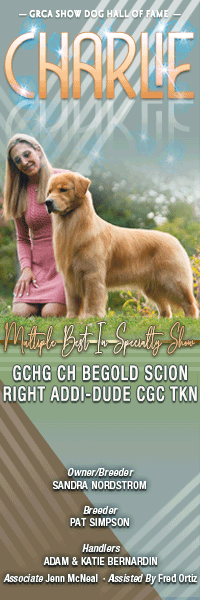Is Blood Really Thicker Than Water?
By: Peri Norman
Originally published: October 2015
 In some ways, we live in a great time to be breeding dogs. Genome projects in both humans and dogs have yielded information about genetic disease and inheritability of traits that have improved our ability to make better breeding decisions and produce dogs more precisely tailored to our preferences. While research in some areas is proceeding at light speed, in other areas, we don’t know any more than we did fifty years ago. The question of littermates and mother/daughter pairs in the same home is one of those questions that continues to plague people who love dogs and yet information of any sort (let alone organized, thoughtful studies) are non-existent to the best of my knowledge.
In some ways, we live in a great time to be breeding dogs. Genome projects in both humans and dogs have yielded information about genetic disease and inheritability of traits that have improved our ability to make better breeding decisions and produce dogs more precisely tailored to our preferences. While research in some areas is proceeding at light speed, in other areas, we don’t know any more than we did fifty years ago. The question of littermates and mother/daughter pairs in the same home is one of those questions that continues to plague people who love dogs and yet information of any sort (let alone organized, thoughtful studies) are non-existent to the best of my knowledge.
A newbie in my breed is, at my persistent recommendation, considering breeding her bitch and keeping a puppy. Her questions were thoughtful. With her permission, I am sharing a portion of her email- “What difference, if any, does gender make? I have heard that adopting siblings is not a good idea because the pups bond to each other and focus on each other rather than the human. How does that relate to if you keep a pup when you already have the mom? Re: keeping a girl pup…what do I need to know about having two bitches in the same house? How much and at what age should I intentionally separate siblings/mom, as opposed to letting them always be together?” Excellent questions!
When I was beginning in dogs, I was taught that siblings should not be kept in the same home together. Nor should pups be raised with their mothers. So I went back through some of my books trying to determine where that advice might have come from. My copy of William Campbell’s book entitled Behavior Problems in Dogs was published in 1975. It was purchased at the UC Davis bookstore in 1984, as it served as a textbook/reference for veterinary students of the time. Campbell’s book has the following comments in a subsection of the Aggressive Behavior chapter labeled Sibling-Type Fighting. It reads in part, “Fighting between canine members of a household usually concerns dogs of the same sex, often littermates. Trigger mechanisms are usually the persons in the family, although sometimes food or another dog may also stimulate fighting. One rule is not to obtain littermates of the same sex, particularly those which appear competitive within the litter.”
The New Knowledge of Dog Behavior by Clarence Pfaffenberger was ground-breaking at the time of its original publication in 1963. It remains a classic work on canine behavior written in the simple and understandable format of a knowledgeable dog man telling the stories about dogs that shaped his understanding. It was reprinted by Dogwise in 2002 and remains, in my mind, a great book and an excellent resource. A large part of this book is about Mr. Pfaffenberger’s work with Guide Dogs for the Blind in San Rafael, California. I found the following quote on page 125 of the reprinted copy, “I cannot remember a single dog who was raised with her mother to adulthood who could be successfully trained for a Guide Dog. Where two littermates are raised together in the same home we have had the same results.” Pfaffenberger continues, “Puppies raised in homes where there are dogs not related to them have never been affected this way by the association with other dogs. This is a field which certainly offers worthwhile, serious study. In the case of two littermates raised together, one becomes a successful candidate for Guide Dog work and one fails, even if their aptitude tests were equal.”
More recently, Another Piece of The Puzzle: Puppy Development edited by Pat Hastings and Erin Ann Rouse contains the following note in Tips and Tricks for Breeders, “Don’t keep littermates. Very seldom will they both reach their full potential.” Oddly, this was the only reference I could find in any of my recent books about keeping littermates and no references at all about keeping her offspring with a bitch. In spite of tremendous increases in studies on and about dogs in the past several years, this particular area of interest still seems lacking systematic research.
Negative admonitions notwithstanding, somewhere along the way I began to keep puppies with their dam, and also kept littermates. At one point I had three Belgian sheepdog littermates living with two Belgian Tervuren siblings from different litters and at least one other, more distantly-related dog (four dogs and three bitches with a mix of intact and altered animals). It was the best group of dogs I have ever owned. Based on everything I was ever taught, these dogs should not have been compatible as an in-home pack. There should have been aggressors and very shy, quiet ones. Some successful with lots of titles and others with none, but that was simply not the case. There was no planning at all to the formation of this pack and yet we did not have problems related to sibling aggression or submissive pack members never reaching their full potential. How did that work, exactly?
Many people, myself included, prefer to have information based on studies. The best ones, of course, are well-designed studies published in peer-reviewed journals and replicated by other teams of scientists. Clearly, however, that high standard for information is not available to address all of our pressing questions. I know that anecdotal evidence is far from definitive. On the other hand, I have often considered that “where there is smoke, there may be a fire”. So I set out to collect people’s experiences and available advice on the subject of keeping littermates and mother/daughter pairs and integrate it with my own insight to try to make some sense of the disparate viewpoints. Just to be clear, my efforts were not in any way a thorough study or complete literature review.
I was surprised that the feedback I received was easily divided into two main camps. Uniformly, trainers and behaviorists are adamant that littermates should not be raised together. (They rarely, if ever, mention raising pups with their dam, perhaps because most of John Q Public spays and neuters their pets so that is less frequently a situation that they deal with.) The horror stories were pretty bad. Well-intentioned folks who obtained two littermate pups from the shelter so the remaining one would not be euthanized and people who purchased a pup from a breeder and then took another one because there were unsold pups made the most frequent appearances in these types of untenable situations requiring professional intervention. I expect this is the most common scenario.
On the other end of the spectrum, I received some replies from experienced breeders like this one, “We have daughters, mothers, grandmothers and a great grandma dog all living together under one roof. We have raised sisters together and never had any issues, ever.” It was enlightening to read the comments from this group of people. Unlike my own experience, many of them had wellthought- out reasons for their success. This comment from Susanne Shelton CPDT:KA, a long-time breeder of German Shepherd Dogs, was typical of the responses I received from this group. “I have no research paper, but after nearly 25 years of raising dams and their daughters we have had no problems. I’ve titled tons of them, they have lived together happily, and we have enjoyed them all. Now, that said, we actively include dog/dog sociability in our breeding criteria, and we have each dog in their own space, and they each have times when they go and do things just alone. I have as many as four generations here at one time, and can’t imagine any other way. Mothers and daughters, fathers/sons, siblings of all kinds.”
This group of highly experienced dog people, who are specific and systematic in how they make close family relations work, often give “do as I say, not as I do” advice to others. Joni Freshman DVM, MS, DACVIM is a widely-respected breeder of Belgian Tervuren whose pack includes siblings, offspring and grand-offspring of her successive matriarchs says, “As a DVM, I always counsel owners (note, most are pet owners) NOT to get two puppies at the same time. Unless they are essentially raised apart from each other (and their dam) with scheduled playtimes daily, they end up very much bonded to each other and not so much to humans. They have a difficult time being separated and do not develop the abilities and personalities they otherwise would. For pet owners who just want ambient dogs, this MAY be ok…until they HAVE to separate them for some reason (hospitalization, etc.) and find out this will NOT go well at all. I have never had a single owner (in over 30 years as DVM) follow my recommendations, but a year later nearly ALL of them tell me they wish they had. Of course, by then it is too late.”
Such things are not always black or white. I have known people who have had challenges keeping littermates or a number of close relatives that were manageable, but not insurmountable. Sadly, many in the fancy end up separating dogs into different rooms or parts of the house, or even warehousing dogs in crates or kennels, to prevent fighting, marking and other negative behaviors. This may impact the quality of the dog’s life to the degree it affects their opportunities to engage in appropriate dog-dog behavior (and sometimes even dog-human behavior). Often these are people who breed dogs seemingly unaware that dog-dog behaviors in general, and dog aggression issues in particular, are important considerations in breeding happy, sociable dogs.
Discussion and research on this issue has led me to some factors that may influence success (or lack thereof) in keeping littermates and other family members together. By far the most important factor, in my opinion, is the level of commitment of the people to making a plan that works for the dogs. Clearly the vast majority of people who keep multiple dogs together in relative peace and tranquility have a system that works well for them. This involves all the dogs getting individualized time, attention, travel and training. In their wonderful booklet, Feeling Outnumbered? How to Manage and Enjoy Your Multi-dog Household, Drs. Karen London and Patricia McConnell logically point out, “Individual time with you is a great reinforcement for your dog and goes a long way toward helping him pay attention to you when you need him to. Most dogs relish your full attention. This may seem obvious, but we couldn’t leave it out. Once you have multiple dogs, it is easy to relate to them as a group, rather than as individuals. But, if your dogs fail to establish a private relationship with you, then their primary relationship will be with the other dogs in your pack.” People who spend a lot of time training and socializing their dogs tend to have fewer difficulties with dogdog relationships. Grooming is an opportunity for one-on-one attention of a quieter sort. Some feel that it is also important to have each dog spend some time alone or be sure that each dog has its own space that it can retreat to for some down time.
Breeders who have generation upon generation of dogs that coexist peacefully with both relatives and unrelated household members are most often thoughtfully bred, high-quality dogs. When asked, one breeder told me that when she is ready to keep a puppy, she simply keeps the one the dam likes the best! On the flip side, I suspect that the vociferous warnings against keeping littermates voiced by professional behaviorists and veterinarians is fueled, at least in part, by the increasing numbers of shelter/rescue dogs and purebreds from substandard breeders replacing quality purebreds in the average home. We know that random-bred dogs or pups from accidental litters are more likely to manifest a number of different physical and temperament problems due to the lack of thoughtful selection of mates and ancestors.
Another practice that is regularly mentioned by breeders who successfully keep mothers and daughters and/or littermates is a period of separation. A block of time anywhere from a couple of days to a couple of months is scheduled for a puppy to go “visit” at a trusted friend’s home or with a trainer or handler. When I leased a bitch for a puppy back, I brought the bitch home over a month before I brought home the puppy. That allowed Mom to get settled back into the pack without the little one in tow, and the pup continued her training and socialization with the dogs in her birth home, obviously absent her dam.
Our lives with dogs are complicated. Those of us who call ourselves “dog people” live, breathe, eat and sleep all things dog. There is no question there are pitfalls to a multi-dog household, and that those pitfalls can be exacerbated by relationships formed in the whelping box. The good news is that appropriate dog-dog behaviors can be born and nurtured in the whelping box as well. A plan that is flexible and responsive to each individual animal’s temperament and desires will allow us to live with and enjoy multiple dogs, regardless of their familial relationship. To quote London and McConnell again, “People who have more than one dog are in a special club of sorts whose members know certain inalienable truths. For example, you know that two dogs are more than twice as much work as one, and that three dogs are as much work as you expected seven to be. But you’ve also probably noticed that the love multiplies faster than the work, and that more really can be merrier.”
Short URL: https://caninechronicle.com/?p=280721
Comments are closed












